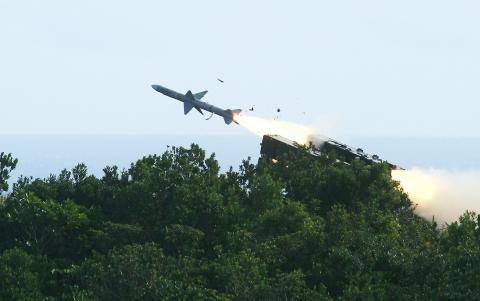Several hundred AIM/RIM-7 Sparrow air-to-air and surface-to-air missiles (SAM) used by the air force have been categorized as “for emergency use only” after three of the US-made missiles encountered technical failures during an exercise in January last year that left the military embarrassed.
Following the exercise, in which one RIM-7 climbed about 200m into the air before plummeting into the South China Sea, while another RIM-7 and one AIM-7 missed their targets, the military requested that US military personnel and Raytheon Corp, maker of the missile, investigate the reasons for the failures.
The Sparrow is a medium-range, all-weather and semi-active guided missile. Six hundred AIM-7Ms were part of a 1992 deal in which Taiwan procured 150 F-16A/Bs.

Photo: CNA
For its part, the RIM-7 SAM is used on towed launchers as part of the Skyguard Air Defense System. Five hundred entered service in 1991.
As Taiwan awaits a response, the air force has suspended the test-firing of Sparrow missiles, citing safety concerns.
The US has reportedly asked countries that have Sparrow missiles in their inventories not to fire them during exercises to diminish training risks. As a result, no Sparrows were fired during another major missile test in Jioupeng (九鵬), Pingtung County, on July 9, the same base used in last year’s exercise.
Citing sources in the military, local media said earlier this week that US military personnel had attributed the failure in last year’s exercise to problems with the missile’s rocket propeller and radar cross section, which plays an essential role in radar range calculation.
Until answers are received, Taiwan’s stockpile of Sparrow missiles will be kept in storage.
To address the impact of that decision on air defense capabilities, the military has reportedly decided to provide two additional battalions with Antelope Air Defense Systems, which are equipped with the a surface-to-air version of the domestically produced Tien Chien I missile.

SHIPS, TRAINS AND AUTOMOBILES: The ministry has announced changes to varied transportation industries taking effect soon, with a number of effects for passengers Beginning next month, the post office is canceling signature upon delivery and written inquiry services for international registered small packets in accordance with the new policy of the Universal Postal Union, the Ministry of Transportation and Communications said yesterday. The new policy does not apply to packets that are to be delivered to China, the ministry said. Senders of international registered small packets would receive a NT$10 rebate on postage if the packets are sent from Jan. 1 to March 31, it added. The ministry said that three other policies are also scheduled to take effect next month. International cruise ship operators

HORROR STORIES: One victim recounted not realizing they had been stabbed and seeing people bleeding, while another recalled breaking down in tears after fleeing A man on Friday died after he tried to fight the knife-wielding suspect who went on a stabbing spree near two of Taipei’s busiest metro stations, Taipei Mayor Chiang Wan-an (蔣萬安) said. The 57-year-old man, identified by his family name, Yu (余), encountered the suspect at Exit M7 of Taipei Main Station and immediately tried to stop him, but was fatally wounded and later died, Chiang said, calling the incident “heartbreaking.” Yu’s family would receive at least NT$5 million (US$158,584) in compensation through the Taipei Rapid Transit Corp’s (TRTC) insurance coverage, he said after convening an emergency security response meeting yesterday morning. National

PLANNED: The suspect visited the crime scene before the killings, seeking information on how to access the roof, and had extensively researched a 2014 stabbing incident The suspect in a stabbing attack that killed three people and injured 11 in Taipei on Friday had planned the assault and set fires at other locations earlier in the day, law enforcement officials said yesterday. National Police Agency (NPA) Director-General Chang Jung-hsin (張榮興) said the suspect, a 27-year-old man named Chang Wen (張文), began the attacks at 3:40pm, first setting off smoke bombs on a road, damaging cars and motorbikes. Earlier, Chang Wen set fire to a rental room where he was staying on Gongyuan Road in Zhongzheng District (中正), Chang Jung-hsin said. The suspect later threw smoke grenades near two exits

The Forestry and Nature Conservation Agency yesterday launched a gift box to market honey “certified by a Formosan black bear” in appreciation of a beekeeper’s amicable interaction with a honey-thieving bear. Beekeeper Chih Ming-chen (池明鎮) in January inspected his bee farm in Hualien County’s Jhuosi Township (卓溪) and found that more than 20 beehives had been destroyed and many hives were eaten, with bear droppings and paw prints near the destroyed hives, the agency said. Chih returned to the farm to move the remaining beehives away that evening when he encountered a Formosan black bear only 20m away, the agency said. The bear